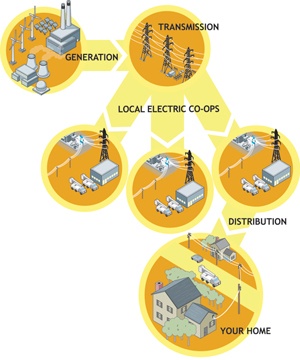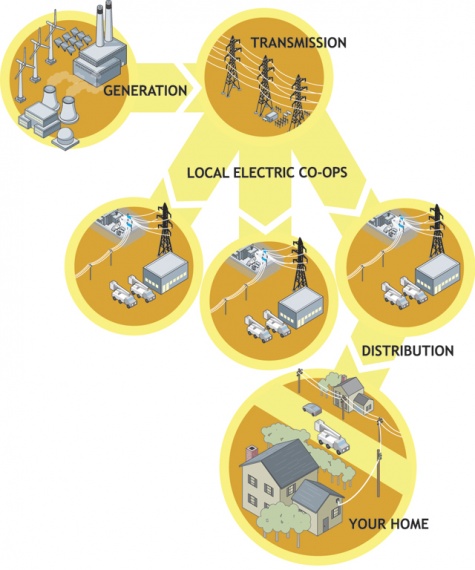Every month, you pay your power bill to your electric cooperative. But have you ever wondered where that electricity comes from?
Generally, it’s not produced in your neighborhood—most electricity travels quite a distance from where it’s generated across heavy-duty transmission lines to reach local distribution systems and, finally, your home.
Along the way, the electricity changes hands a few times. But co-op members are lucky—in most cases, different types of consumer-owned electric cooperatives are involved at each step to keep power flowing safely, reliably and affordably.
Different Co-ops, Same Goal
Your home or business receives electricity from your co-op, one of roughly 860 electric distribution cooperatives in America. These local, member-owned, not-for-profit utilities build and maintain overhead and underground lines and equipment to deliver power. Typically, distribution co-ops do not generate electricity or directly negotiate with power providers. In most cases, that role lies with generation and transmission cooperatives (G&Ts).
G&Ts are wholesale power suppliers owned and governed by electric distribution co-ops. They produce electricity directly and/or buy it in bulk from other companies, then ship the power over high-voltage transmission lines (whether owned or leased) to local distribution co-ops.
The first G&Ts were created shortly after the birth of rural electrification in the 1930s and early 1940s by groups of distribution co-ops and other publicly owned utilities. The idea was simple: By forming G&Ts, distribution systems could reduce costs by collectively negotiating power supply arrangements and achieve a better price without being held captive by other power generators.
Today, there are 65 G&Ts. There are 10 that serve Texas alone. A few serve more than 100 distribution cooperatives in several states while others operate in smaller areas. Seventy-eight percent of distribution co-ops receive at least some of their electricity from a G&T.
Generation
Right from the start, many G&Ts began building and operating generating stations. Currently, G&Ts generate about 5 percent of the nation’s electricity and own all or part of 200 generating plants with a combined capacity of more than 51,000 megawatts (MW). That’s enough electricity to power approximately 10 cities the size of Las Vegas.
Overall, 45 percent of the power used by distribution co-ops nationally comes from power plants fully or partially owned by G&Ts. Coal-fired facilities account for more than half of the electricity produced by utilities nationally, followed by nuclear power and natural gas. Nineteen G&Ts feature green power generated from wind, solar, biomass, hydro and other renewable resources.
Transmission
Once generated, electricity can’t be stored efficiently. Instead, G&Ts make sure that energy reaches local distribution co-op systems over high-voltage transmission lines. The more electricity packed onto a line (by increasing the voltage), the farther it will travel. Once power reaches its destination, distribution co-ops use transformers at substations to reduce the voltage before sending it over their lines to your home or business.
G&Ts own and maintain a national network of 66,584 miles of transmission line to deliver power to local distribution co-ops—enough to go around the world more than 2 1/2 times. The distribution co-ops own and maintain 2.6 million miles of line, 42 percent of the nation’s total. Texas distribution cooperatives own and maintain more than 306,000 miles of line, enough to trace the state’s border more than 100 times.
——————–
Megan McKoy-Noe writes on consumer and cooperative affairs for the National Rural Electric Cooperative Association.


